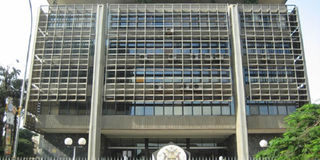BoU projects economy to grow at 6.5%

Bank of Uganda
What you need to know:
In the Monetary Statement issued by Bank of Uganda deputy governor Michael Atingi-Ego, the Central Bank said after assessing macroeconomic and balance of risks outlook, they had decided to keep the Central Bank Rate at 6.5 percent, which is consistent with meeting inflation target of 5 percent sustainably in the medium term while supporting economic growth recovery
A Bank of Uganda (BoU) has said that despite both internal and external difficulties, the economy is projected to fully bounce back from challenges experienced last year.
The rebound, the Central Bank said, will spur economic growth expected to expand in the range of between 6.5 percent and 7 percent.
In the Monetary Statement issued by Bank of Uganda deputy governor Michael Atingi-Ego, the Central Bank said after assessing macroeconomic and balance of risks outlook, they had decided to keep the Central Bank Rate at 6.5 percent, which is consistent with meeting inflation target of 5 percent sustainably in the medium term while supporting economic growth recovery.
“Indeed, the high frequency indicators of economic activity for October 2021 to January 2022 suggest that the economy was on a strong rebound. Domestic demand is making a strong comeback related [to easing of] restrictions, adding to the gains from robust external demand,” he said, considering that recovery and signs that the effect of the Omicron on economic activity has been relatively small, the outlook for economic growth is more positive than earlier projected.
However, Dr Atingi-Ego warned that lower global growth, continued supply chain disruptions, and tighter global monetary and financing conditions could constraint external demand thus noting that recovery might remain fragile and uneven across sectors.
The Central Bank also noted that risks to growth outlook remain, resulting from uncertainty about the evolution of the pandemic and uncertainty in public investment.
Dr Atingi-Ego said slow execution of public investments and delays in oil investments could dampen growth outlook, exacerbated by a global economic slowdown, prolonged supply chain bottlenecks, and geopolitical tensions.
Growth, he noted, could also be dampened by global inflationary pressures thus resulting into a change in investor risk sentiment and the associated tighter domestic financial conditions.
However, the Central Bank noted that local inflationary pressures remain subdued, but warned inflation could accelerate in months ahead owing to a rise in energy and food prices.
Household spending, particularly on services, is forecast to be higher due to the full reopening of the thus presenting the threat of a rise in inflation but will remain below the 5 percent target.
Significant risk
According Dr Atingi-Ego, there are considerable uncertainties surrounding the outlook with the most significant risk presented in the duration of disruptions to the global production chain and stronger inflation pressures.




